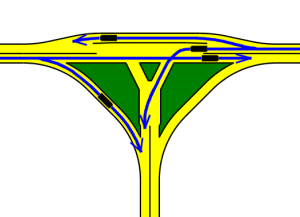Automated Microbus Intersections
 A wide variety of Automated Microbus roadway intersections are possible, but an at-grade "T" is all that's needed for many applications. The diagram at the right shows the intersection of a two-way mainline with a two-way branch line. All possible turning movements are allowed. The diagram is to scale, and the vehicles shown are 12.5 ft (3.8 m) long. This design replaces a roundabout-based design that was previously shown on this page. It resulted in excessive turning by mainline vehicles that were just continuing straight through the intersection. Some network diagrams on this site still use the older roundabout design, but the North Bethesda network has been updated.
A wide variety of Automated Microbus roadway intersections are possible, but an at-grade "T" is all that's needed for many applications. The diagram at the right shows the intersection of a two-way mainline with a two-way branch line. All possible turning movements are allowed. The diagram is to scale, and the vehicles shown are 12.5 ft (3.8 m) long. This design replaces a roundabout-based design that was previously shown on this page. It resulted in excessive turning by mainline vehicles that were just continuing straight through the intersection. Some network diagrams on this site still use the older roundabout design, but the North Bethesda network has been updated.
The T intersection shown here is designed to operate with no central control. Each vehicle is autonomous, and uses its on-board sensors and computer to safely navigate across the paths of conflicting vehicles. The control system is described in more detail elsewhere, but briefly, each vehicle knows its exact location, and at each conflict point one lane has permanent priority, and vehicles in the other lane know they must yield.
 The possible paths of mainline vehicles are shown at the right. Those continuing straight through have the highest priority and never have to yield. Vehicles turning right from the mainline traverse a 90 degree ramp and yield when merging onto the branch line.
The possible paths of mainline vehicles are shown at the right. Those continuing straight through have the highest priority and never have to yield. Vehicles turning right from the mainline traverse a 90 degree ramp and yield when merging onto the branch line.
Vehicles turning left from the mainline must cross the path of mainline vehicles traveling in the opposite direction. The turning vehicles must yield. There is space for one mainline vehicle turning left to wait for an opening without blocking mainline vehicles behind it that are passing through.
In order to hold lateral acceleration and jerk within comfort limits, speed in limited to 10 mph (16 kph) on the 90 degree ramps and on the offset mainline lane that runs from right to left. For safety reasons, it's proposed that the mainline lane that runs from left to right slow to 5 mph (8 kph) where it crosses the path of turning vehicles in the center of the intersection.
 Vehicles approaching the intersection on the branch line must turn right or left as shown in the diagram to the right. Those turning right traverse a 90 degree ramp and yield when merging onto the mainline.
Vehicles approaching the intersection on the branch line must turn right or left as shown in the diagram to the right. Those turning right traverse a 90 degree ramp and yield when merging onto the mainline.
 Vehicles approaching the intersection on the branch line and turning left must cross three conflicting paths, and must yield in all three cases. In the diagram on the right, a branch-line vehicle turning left must first yield to mainline vehicles that have just turned left, then to mainline vehicles traveling left-to-right, and finally to mainline vehicles traveling right-to-left. As shown, there is room for one vehicle to wait just before each conflict point. This allows the turning vehicle to cross one conflicting path at a time, thus improving intersection throughput.
Vehicles approaching the intersection on the branch line and turning left must cross three conflicting paths, and must yield in all three cases. In the diagram on the right, a branch-line vehicle turning left must first yield to mainline vehicles that have just turned left, then to mainline vehicles traveling left-to-right, and finally to mainline vehicles traveling right-to-left. As shown, there is room for one vehicle to wait just before each conflict point. This allows the turning vehicle to cross one conflicting path at a time, thus improving intersection throughput.